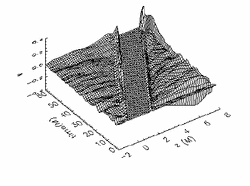Moving a Black Hole
According to general relativity, a large accelerating mass produces ripples in spacetime, just as accelerating charges generate electromagnetic radiation. In the 80 years since that prediction by Einstein, no one has directly detected these “gravity waves,” but that may change in the next decade, as a new generation of detectors goes online. These detectors will rely heavily on computer simulations to identify and interpret the expected minuscule signals from cosmic events, but the computations pose unprecedented challenges. In this week’s PRL, the largest collaboration ever to attack the problem demonstrates a step forward–the reliable simulation of an isolated black hole moving in three dimensions.
The detection of gravity waves could open up a new type of astronomy with a new way of looking at the universe; until now astronomers have only observed in the electromagnetic spectrum. To help in the detection process, the Binary Black Hole Grand Challenge Alliance formed in 1993 with the goal of predicting gravitational waveforms of a coalescing black hole pair, one of the most promising events for producing detectable gravity waves. Along the way the team hopes to develop the computational tools to study general relativity and astronomical events in the previously inaccessible strong-gravity regime.
Black hole simulation is difficult for several reasons. First, the Einstein equations are not simple: Ten second-order, nonlinear differential equations must be solved at every point in a four-dimensional spacetime grid. Second, black holes contain singularities, so points within the event horizon must be excised–excluded from the calculation–but are reintroduced as they emerge from the black hole. Third, general relativity allows complete freedom in choosing three-dimensional, spacelike slices of spacetime, just as an apple can be sliced into flat pieces or any curvy shape a chef desires. A poor choice leads to coordinate pathologies, such as two distinct points becoming infinitely far apart, but the only way to check a coordinate choice is to test it in a computation. A fourth difficulty comes from the inherent imprecision of numerical methods: As time evolves in the simulation, spurious ripples develop which spoil the run if they become amplified.
In the latest PRL paper, the Alliance demonstrates progress in a number of these areas. They report the first full, three-dimensional simulation of a moving black hole lasting for a significant time. In the standard G = c = 1 units, space and time event horizon is at a radius of 2 M), and the Alliance simulated a black hole for a time of 60 M. The group used a spacetime slicing scheme which ran successfully for this time, and their method of bringing points back into the computation as they emerge from the hole introduces only small errors, which fade with time and distance (see figure). As the team develops this method for “strong-field” simulation close to the hole, they will eventually combine it with other simulation modules from the Alliance [Phys. Rev. Lett. 80, 1812 (1998) and one soon to be published in PRL] which extract the far-field radiation–the signal we would see from Earth. Richard Matzner, of the University of Texas at Austin, and the director of the Alliance, says he has a “nebulous bet” with Kip Thorne, of the California Institute of Technology, in Pasadena, CA. Thorne is one of the leaders of the LIGO (Laser Interferometer Gravitational-Wave Observatory) project, and Matzner bets the Alliance can calculate binary black hole waveforms before LIGO can begin observing them in late 2001.



